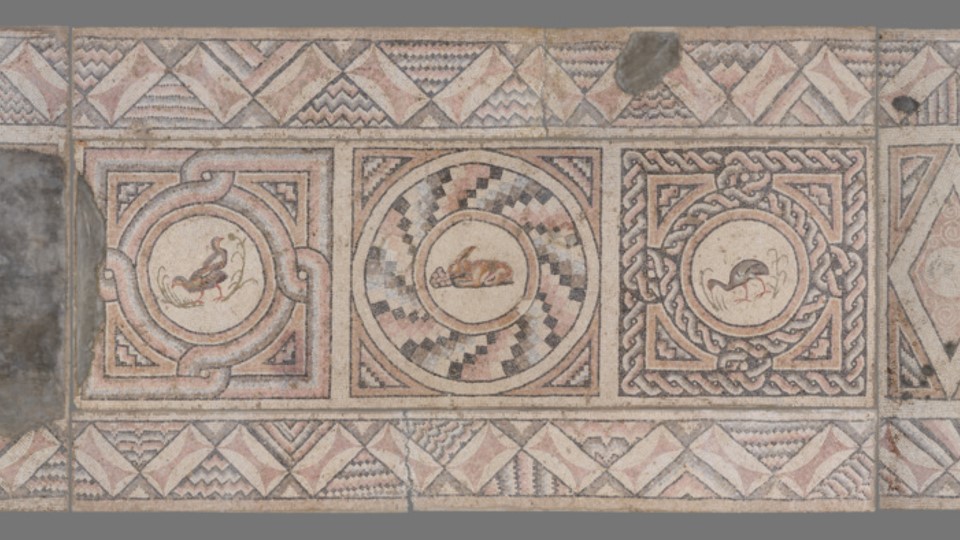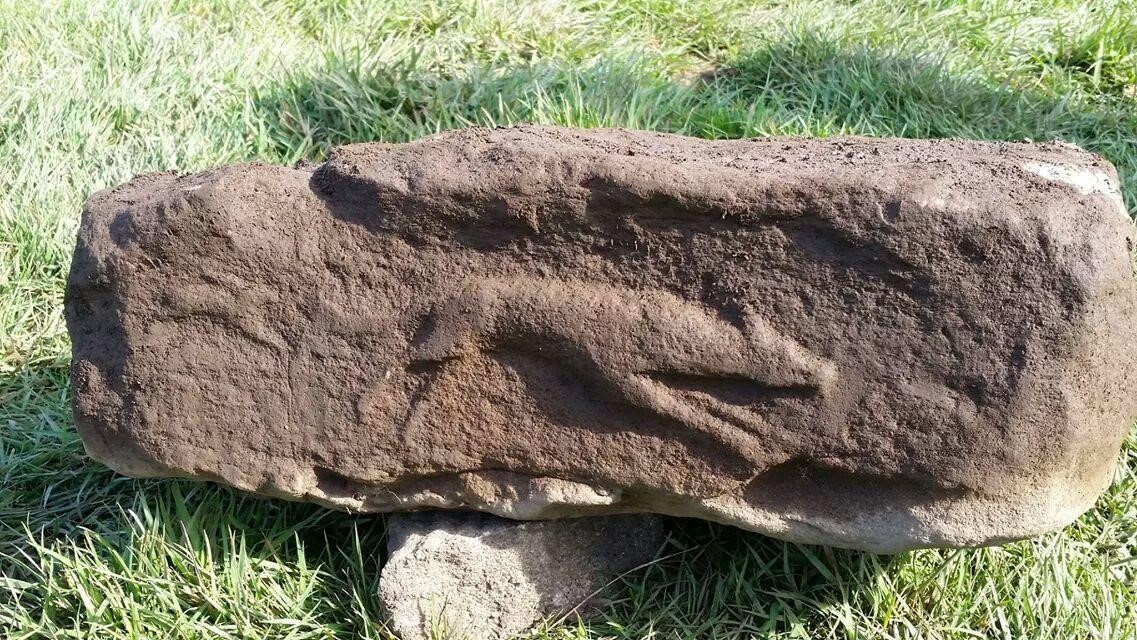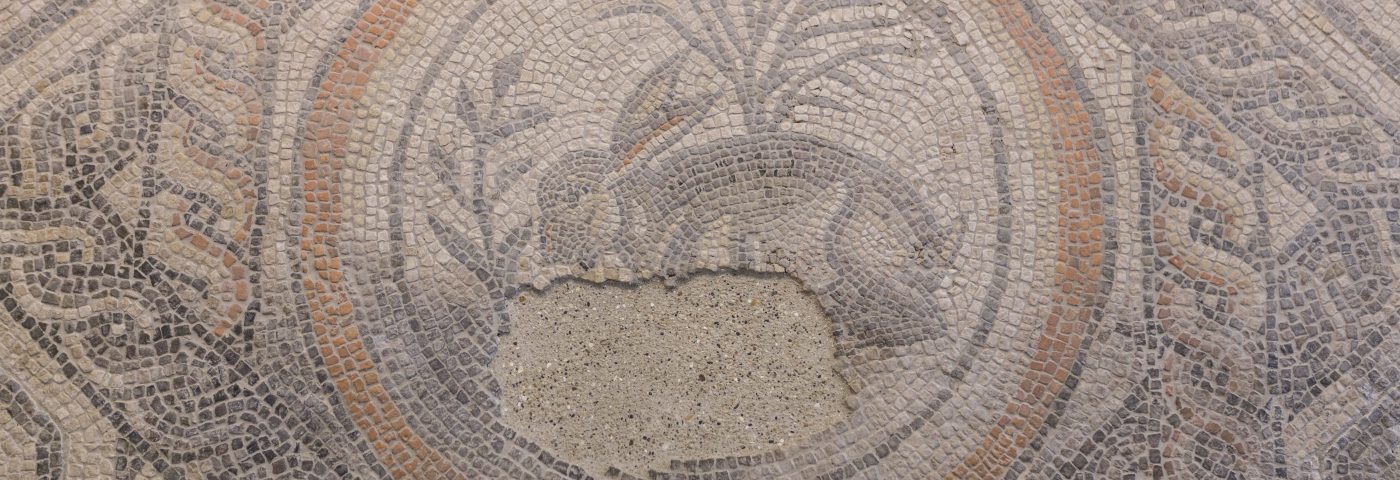Isobel is one of our summer intern placements. She is currently studying at Utrecht University and has an interest in the classical world.
Hares have been a significant mythological figure and artistic motif in countless cultures throughout the course of history, and the prevalence of hares in ancient Rome and pre-Roman Iron Age Britain alike made for an interesting cultural interaction upon the Roman invasion of Britain, which has left traces in the material culture created in the aftermath.
The symbol of hares appears frequently throughout antiquity, from Ancient Egypt to Classical Greece and Rome. An early example of this is the fable of Aesop about the slow and steady tortoise outwitting and outrunning the overconfident hare in a race. Due to their speed and agility, hares were a favourite hunting prey of Greeks and Romans alike, and most artistic representations of hares are related in some way to the hunt: there is even a depiction of what appears to be a hare chasing a hunting dog from Vindolanda, UK. Hares were widely considered to represent both fertility and sexual desire. Herodotus, Aristotle, and Pliny all wrote about the fertility of hares, which was considered in conjunct with their prey-like vulnerability, creating a dynamic in which the survival of hares was perceived to result only from their prolific breeding. Hares were thus associated with the circle of life, and by extension, with spring, renewal, and immortality.
Hares were sacred to Venus/Aphrodite and Eros in the ancient Roman and Greek religions respectively and are often portrayed in depictions of the love goddesses. Ancient Greek practices even involved engraving hares on wedding rings and wedding bowls, and in both cultures, it was commonplace for lovers to exchange live hares as gifts to one another. The luckiness of a rabbit’s foot still familiar today also dates back to antiquity, with hares understood to be symbols of luck in late antiquity, perhaps a contributing factor to their hunted status.
It was previously thought that the Romans introduced the brown hare to the British Isles, given that hares were so important to Roman culture and would therefore have been transported with soldiers and settlers. However, recent evidence suggests that these hares were already established when the Romans arrived in Britain; although, that is not to say that the Romans had little impact on the place of hares in culture and society.
There are three species of hare in Britain: the mountain hare (mostly found in Scotland), the Irish hare (mostly found in Ireland), and the brown hare (mostly found in England and Wales). Cave fossils suggest the Irish species was present in the country up to 30,000 years ago, whereas the earliest evidence of the brown hare in the UK dates to between the fifth and third centuries CE. Where evidence of human interaction with hares has been found from pre-Roman Britain, hare bones were buried with great care and moreover with no indication of butchering, demonstrating that they were not perceived as a suitable foodstuff and suggesting that they may have been sacred. Material heritage such as jewellery featuring hare designs also suggests the worship of a Brittonic hare deity before the arrival of the Romans, similar to the classical association of hares to Venus or Aphrodite. It has been suggested that the goddess of dawn and the spring equinox, Eostre, who gave her name to Easter in the Germanic languages, was likely associated with hares; this also explains the relation of hares (and more recently, bunnies) to the Christian Easter.
Observing the iron age Britons in their early interactions, Caesar commented that they did not regard it ‘lawful’ to eat hares, but that they did breed them for ‘amusement and pleasure’, perhaps even keeping them as pets. On the other hand, even the earliest Romans to arrive in Britain practiced cuniculture, keeping their hares fenced in warrens as a source of fur and food; archaeological evidence of hare bones found in Roman settlements indicates their consumption. The archaeological evidence of complete and undamaged hare skeletons corroborates this account. Furthermore, Cassius Dio relayed a speech of Boudicca, explaining how she used a hare for public divination. The hare was concealed beneath her dress until it was allowed to run out from under her, which it did on what the tribe considered to be the auspicious side, causing the crowd to cheer and Boudicca to thank Andraste, the goddess of war, for this good sign. This reiterates the special position held by hares in the Brittonic society, and the status of hares around the time that the Romans arrived in Britain and the two cultures began to interact.
A primary example of a hare in Romano-British art is the fourth-century hare mosaic of the Corinium Museum. August 2021 marks the fifty-year anniversary of the excavation of the artwork in modern Cirencester, on Beeches Road in 1971. This mosaic demonstrates one of the most accomplished depictions of an animal in Romano-British artwork, an example of this mastery being the clear glass tesserae (tiles) used to highlight the fur of the hare’s back. This imagery is also unique for its content: hare artworks are not prevalent, but instances of hares in Romano-British iconography are typically hunting scenes, in which the prey is pursued by a hunting dog. The image of a hare at rest, peacefully grazing, is close to unique and accordingly significant.

It therefore seems that the Corinium hare mosaic reveals a fusion of Roman and Brittonic cultures in the town during the fourth century. Whilst the mosaic illustrates an exceptional example of a quintessential Roman artform in a prosperous Roman town, its subject is inarguably Brittonic in its reverence towards the hare. Therefore, no matter the ethnicities of the artist, patron, and by extension the inhabitants of Corinium, the hare mosaic suggests that their cultural identities were as duplicitous as the hare is as an artistic symbol. The appreciation of the hare, demonstrated in its peaceful situation and beautifully detailed depiction, materialises the Brittonic perception of hares as special animals, the opposite of a creature to be hunted and butchered. Notwithstanding, this appreciation has been realised through a Roman treatment in glass tesserae to create a striking floor piece for a villa or Roman public building. This suggests the simultaneous Roman and Brittonic identities of those who were involved in the creation of the mosaic and would have acted as a contemporary symbol of cooperation and integration for all those, Roman, Brittonic, or somewhere in between, who looked down at this tiled grazing hare.
Another museum collection piece of interest is the kindred hare mosaic of the Getty Museum, which dates from approximately 400 CE and depicts a hare at rest eating grapes. The other hare objects of the Getty Museum are more typical in their representations of hunted hares, but this mosaic floor from the Baths of Apolausis (a Greek word meaning enjoyment), in ancient Antioch (modern-day Turkey), is in the same rare category as our own Corinium hare mosaic. The mosaic is notable for its elaborate geometric patterns and pastoral motifs of animals and fruits, including birds pecking at foliage and the central hare at peace, as well as its muted colour scheme, and each of these characteristics is reminiscent of the Corinium hare mosaic. The excavation of this mosaic took place in 1938, after the small public baths were discovered by a local farmer; this animal mosaic constituted the vestibule of the frigidarium (cold-water room). The impeccable construction and opulent decoration of the Baths of Apolausis attest to the wealth and patronage of the surrounding upper class.

As much as the domestic and multicultural situation of the Corinium mosaic contributed to its creation, the location of this Antioch hare mosaic in public baths in the eastern empire during late antiquity has influenced its production. A distinguishing feature of public baths in this cultural and temporal context was the habitual transformation of the frigidarium into a apodyterium, a spacious lounge used for public gathering and entertainment, compounding the social and cultural function served by bathhouses. The pastoral motifs are not without significance, considering that the baths were a place to relax, rejuvenate, experience pleasure, and soothe pains. The association of hares with vitality renders this image a sound choice for the entrance to a pool, and its depiction at peace, relaxing and snacking on fruit, is much more appropriate than fleeing chase from a hunting dog and would remind the visitor of their reason for a trip to the baths. The overall theme suggested is pursuit of the good life, eternal life, and general contented wellness; this is emphasised by the geometric design and the round pattern surrounding the hare, symbolising the circle of life.
The Vindolanda Trust which safeguards the ancient Roman fort in Northumbria just south of the later Hadrian’s Wall also has in its collection a hare object of interest. This stone carving was once part of a larger relief, and this piece depicts the comical inversion of a hare chasing a hunting hound. Despite the initial impression that this may be a purposeful, parodical joke, the context of the stone both as part of a larger relief and as an artwork from a Romano-British fort would seem to suggest otherwise. It is most likely that the original purpose of the stone relief was to depict a typical Roman hunting scene, in which the hare would indeed be the target and the prey. Although the stone comes from Roman Britain, the context of a fort inhabited almost solely by troops employed by the Roman military would have much less interaction with the native (hare-loving) Britons than the town of Corinium did. This serves to explain the discrepancy between two relatively geographically close locations: they had a cultural difference due to the lack of settlement and integration.

Therefore, the Corinium hare mosaic has much to show about Roman and Romano-British art, and about intercultural relations both in Corinium and elsewhere. The hare in Roman art may be understood to be a multifaceted symbol of agility and vulnerability, of fertility and death, and of cunning and foolishness. The Corinium hare mosaic capitalises on these dualities, portraying a scene which may not necessarily have been expected, but which is the result of harmony between Romans and Britons cohabiting in ancient Corinium and producing beautiful mosaics.
References / Further Reading
https://www.sainsburycentre.ac.uk/art-and-objects/roman-crouching-hare/
Hares, hair and cultural identity – a tombstone portrait from Lincoln
https://en.wikipedia.org/wiki/Rabbits_and_hares_in_art
https://www.thefield.co.uk/country-house/why-we-are-all-mad-for-hares-21624
https://www.lottibrowndesigns.com/blog/celtic-hare-art-hare-meaning-symbolism
https://www.smithsonianmag.com/smart-news/hares-and-chickens-were-godsnot-food-ancient-britain-180974663/
https://www.getty.edu/publications/romanmosaics/catalogue/7/










